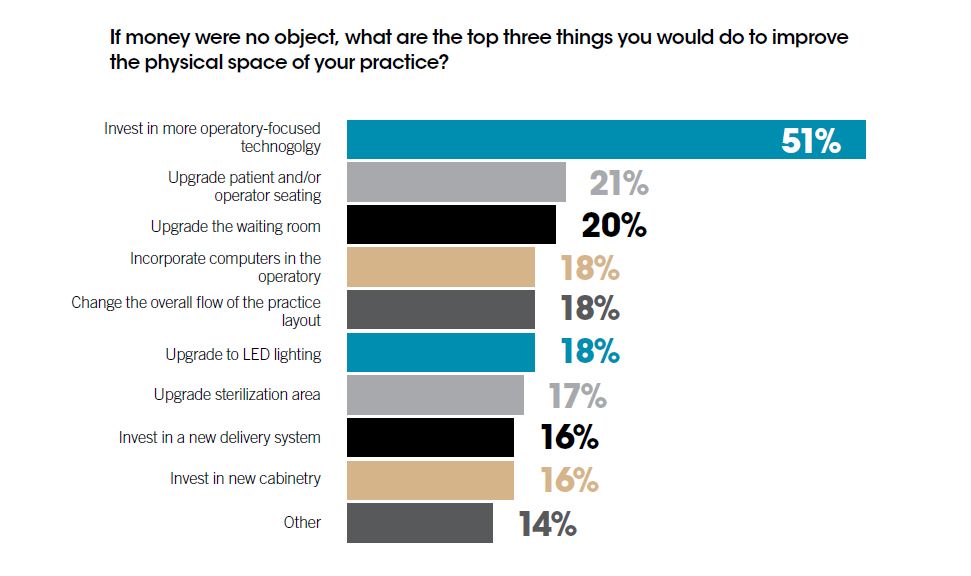What you said matters most when it comes to dental office design [SURVEY]
We’ve all heard the saying, “If it’s not broke, don’t fix it.” Well, what you told us, among other things, in this year’s dental office design survey is that even if you think it is broke, you’re still not going to fix it any time in the near future.
We’ve all heard the saying, “If it’s not broke, don’t fix it.” Well, what you told us, among other things, in this year’s dental office design survey is that even if you think it is broke, you’re still not going to fix it any time in the near future.
During the latter stages of 2013, we asked Dental Products Report readers to let us know what they thought about their practices and 756 of you took the time to respond (for that, we thank you). Of those respondents, 67 percent were satisfied with the current design of the front office and waiting room and 68 percent were satisfied with the current design of the operatories and back office.
Here’s where we could take the glass is half-empty or half-full viewpoint. While we’re very happy to hear that two out of three dentists who took our survey are happy with their current setup, it also means one out of three is not.
We tried to dive in a little deeper with the group who was unhappy with their setup and we asked a simple question: Do you plan to re-model within the next 12 months?
The majority said no, with 68 percent of the unhappy dentists saying they’ll stick with their current setup in the operatories and 72 percent saying the same for the front office and waiting room.
Even more interesting is the fact that 69 percent of survey respondents believe that patients see office design as a reflection of their competence in the dentist and the practice as a whole.
So, knowing this, if money were no object, would our respondents do a complete remodel of their practice? Only 18 percent said they would.
RELATED: Dr. Steven Koos explains why he doesn't hide his practice’s sterilization area
“When you’re talking about a complete remodel of the practice, you must focus on improving efficiency, productivity, and projected return on investment, not perseverate on the costs associated with investing in the achievement of those goals,” said Garrett Ludwig, who runs Diversified Design Technologies in Connecticut.
“It’s not something that you enter into lightly. Like anything worthwhile, it takes time and effort on the part of the designer and the dentist, but the ultimate financial yield is predictable and gratifying.”
But when we talk “office design,” we’re not just talking about matching colors and a brand new building.
Office design also takes into consideration the flow of the office and how the layout of the practice makes it more or less efficient.
With that in mind, we asked you, on a scale of 1-5, what was important to you about the “design” of your practice. Given that 5-point scale, respondents ranked efficiency at the top (4.7), followed by ergonomics (4.6) and esthetics (4.5).
“Absolutely, everyone wants to work in a beautiful, state-of-the-art dental practice, but that’s not possible,” said Michigan-based Mary Govoni, a practice management consultant who specializes in efficiency and ergonomics. “What’s more important is that the dentist and team members look at how smoothly their current practice is running and see what can be done to improve efficiency.”
The importance of ergonomics in the practice has been greatly emphasized over the last few years and the message seems to be striking a chord with dental practitioners. In our July 2007 ergonomic survey, 86% were satisfied or very satisfied with their operatory setup. In this year’s survey, 91% were satisfied or very satisfied.
“That’s great to hear because you could work in the most beautiful practice in the world, but if you’re going home every day with aches and pains and your career is shortened because of how you’re working, it doesn’t matter,” Govoni said.
How Dentists Can Help Patients Navigate Unforeseen Dental Care
December 12th 2024Practices must equip patients with treatment information and discuss potential financing options before unexpected dental treatments become too big of an obstacle and to help them avoid the risk of more costly and invasive procedures in the future.
